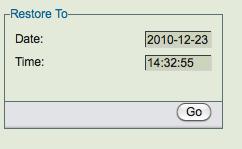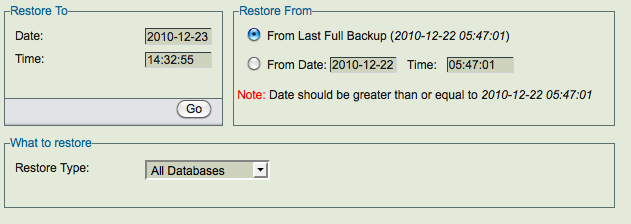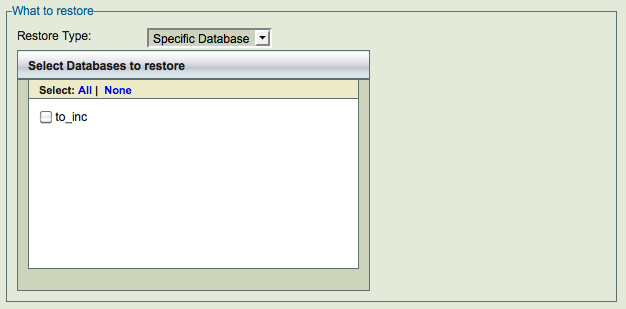Table of contents
- 1. Restore What
- 1.1. Restore From
- 1.2. What to Restore
Restore What
This is the first step in the restoration process.

- Restore To
- If you came to this page using one of the report links (which is recommended), the date and time will be filled in based on the link that you clicked to get to this page. Otherwise enter a date and time to match the date and time you want the backup restored to.
- Go
- After you click Go, the ZMC validates your entry by looking for an existing backup and displays more options as appropriate. These options are described in the sections that follow.
Restore From
If users are restoring from a Full Backups and no incremental backups exist, then the backup set just prior to the time entered will be used to restore the data.

When incremental backups exist, ZMC for MySQL provides the ability to restore till the specified time. One of the more common reasons for a restore is to roll back the database to the point before a particular event (such as a mistake or malicious activity) damaged the database. In that case, you should use the Database Events viewer to launch the restore, and all of this information will be automatically prefilled on the Restore What page.
If the Restore from time is not specified, ZRM restores the most recent full backup and also looks at the subsequent incremental backup for transactions to restore to fulfill the user-specified Restore to time.
For example: A full backup was completed on Oct 8 at 16:17:29 and the next incremental backup occurred on Oct 8 at 18:00:00. If you specify a Restore to time of Oct 8, 16:17:29 and do not specify a "restore from" time, ZRM restores from the full backup dated Oct 8, 16:17:29 and all transactions that are present in the next incremental backup (Oct 8, 18:00:00) that occurred at Oct 8, 16:17:29.
What to Restore
- All Databases
- When the default choice, All Databases is accepted, the GUI does not change any further. Note that in this context the term All Databases means all the databases that have been backed up as part of the current backup set; such a restore could be all databases, selected databases, or selected table(s).
- Specific Database
- Choose this option to display the list of databases backed up within the set.

Restoration of specific table(s) is not supported with InnoDB storage engine tables. The InnoDB table space contains information about all tables in the database and will have to be restored.
- Clicking Next Step button Initiates an error checking routine, first checking that the Go button has been clicked first. If the Go button has not been clicked, you are prompted to do that. You must correct any errors displayed by clicking Go before you can proceed to the next step. If there are no problems, clicking Next Step takes you to the Restore Where page, with parameters in the Restore What page saved and transferred to Restore Restore page.
